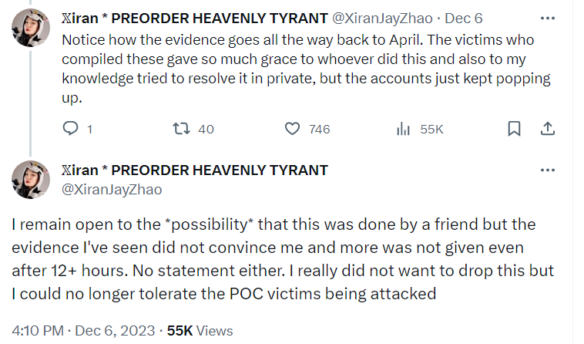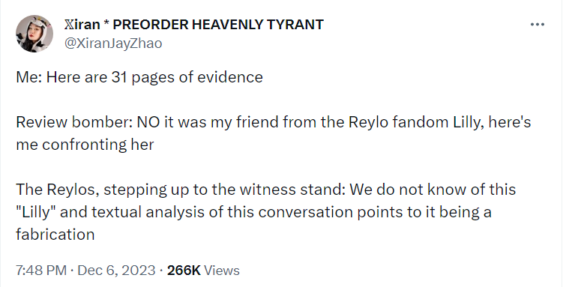(1) OH WHAT A TANGLED WEB THEY WEAVE. Two days ago Xiran Jay Zhao cast a spotlight on reports that a debut author was on Goodreads dropping one-star reviews. Initially, they did not plan to name the person. Original thread starts here.


The person’s forthcoming book was reportedly getting good buzz of its own, and they have “a major social media following”.
Xiran Jay Zhao subsequently decided to share documentation supporting the identification of Cait Corrain as the author behind the one-star reviews. Thread starts here. Here are the “Review Bomb Receipts” they made available at Google Docs. Among the questions raised in the Receipts: “Why a Goodreads account confirmed to be theirs upvoted their book on the same ~37 obscure lists the fake accounts did”.

There has been an attempt to lay off these reviews on a different bad actor, saying it’s not Cait Corrain but a fan from her ReyLo fanfic.


Twitter user Natalie Lief did a roundup from the various social media involved. Thread starts here.
An immediate consequence to Cait Corrain is that K.B. Wagers withdrew a blurb provided for Corrain’s upcoming book. Thread starts here.
Meanwhile, @CaitCorrain has taken their Twitter and Instagram account private.
(2) AFI PICKS. The American Film Institute named its top 10 films and television shows of 2023: “AFI Top 10 Awards”.
AFI Top 10 Motion Pictures of the Year
- American Fiction (MGM)
- Barbie (Warner Bros.)
- The Holdovers (Focus Features)
- Killers of the Flower Moon (Apple Original Films/Paramount Pictures)
- Maestro (Netflix)
- May December (Netflix)
- Oppenheimer (Universal Pictures)
- Past Lives (A24)
- Poor Things (Searchlight Pictures)
- Spider-Man: Across the Spider-Verse (Sony Pictures)
AFI Top 10 Television Programs of the Year
- Abbott Elementary (ABC)
- The Bear (FX)
- Beef (Netflix)
- Jury Duty (Amazon Freevee)
- The Last of Us (Max)
- The Morning Show (Apple TV+)
- Only Murders in the Building (Hulu)
- Poker Face (Peacock)
- Reservation Dogs (FX)
- Succession (Max)
(3) OCTOTHORPE. Episode 98 of the Octothorpe podcast, “Finally, Manitoba”, has “a stunt Liz in the form of Sandra Bond and a stunt lizard adorning Alison’s cover art. We discuss the fan funds, we discuss NASFiC, and we have an excerpt from Sandra’s TAFF report which is most excellent.”
Sandra Bond explains more clearly: “As I foretold, the first piece of my TAFF report is now available, dealing with Canadian adventures immediately after Pemmi-Con. Notably, this marks the first time ever (I’m pretty sure) that such a chapter has made its debut in a podcast rather than a paper fanzine — namely episode #98 of Hugo-nominee Octothorpe. The episode contains much discussion of fan funds, their nature, and their place in modern fandom, too.” Bond says the full chapter will also appear in a fanzine in due course.

(4) HOW DO THEY KNOW? Karen Myers has some interesting ideas about “Spreading the news offstage” in a post at Mad Genius Club.
All sorts of interesting things are happening to your primary characters. But what’s going on with the rest of the cast? How do they hear about the broad events in the lives of the main players? Do they pick it up from gossip? Do they read it in the news and discuss it among themselves?
If you want a bit player to show up on stage to sympathize with your hero in his travails, how does he even know about them? What about the cute shopgirl who’s just realized the hero’s available? Even the villains have to monitor their targets to track the progress of their plots.
Accounting for this offstage knowledge in the story without tedium is an art in its own right. Something as simple as “I heard about it from X” can illuminate the information trail, assuming that the speaker knows X and X has a plausible news source, too. That’s often the method used for groups of bit players, like servants in a household where gossip is presumed to spread….
(5) WHAT ARE SCHOOL LIBRARIES FOR? “Florida AG Says School Libraries Are for “Government Speech,” Not Free Expression” – Them/Us analyzes the AG’s amicus brief.
Florida’s attorney general is claiming that the state’s public school libraries are “a forum for government speech” and “not a forum for free expression,” in a chilling argument that appears to be gaining steam on the right.
In May, free speech and literary nonprofit PEN America filed a lawsuit against Florida’s Escambia School District. The additional plaintiffs in the case are Justin Richardson and Peter Parnell, writers of And Tango Makes Three, a picture book depicting real-life gay penguins and one of the country’s most banned books over the past two decades. The plaintiffs allege that when Escambia schools removed Richardson and Parnell’s book from shelves this year, administrators were “depriving students of access to a wide range of viewpoints” and engaging in “viewpoint discrimination,” violating the First Amendment.
But Florida Attorney General Ashley Moody, a Republican who took office alongside Gov. Ron DeSantis in 2019, filed an amicus brief in August arguing the opposite. Though the state itself is not a named party in the case, Moody filed the brief on the grounds of “preserving the government’s authority to decide for itself what materials to curate” in school libraries.
“Florida’s public-school libraries are a forum for government, not private, speech,” Moody argues in the brief, comparing the removal of LGBTQ+ books like Tango to school policies against Nazi propaganda. Although Moody admits in the brief that appeals courts have “not yet addressed” the legal argument she makes, she cites semi-related precedents — such as whether a state can refuse to display a religious monument — to conclude that “the compilation of library materials is government speech.” For that reason, she continues, removing any library materials cannot constitute viewpoint discrimination….
(6) DATA CENTERS ARE LOOKING UP. [Item by Daniel Dern.] I’m curious what the job requirements list for (on-site) support for potential hires would include. (Also whether this is a Bond or other thriller movie waiting to happen…) “Project Cuts Emissions By Putting Data Centers Inside Wind Turbines” – via Slashdot.
CNN reports on a new German-based project called WindCORES that operates data centers inside existing wind turbines, making them almost completely carbon neutral.
Its solution was to bypass the ‘middleman’ (the grid) altogether, and instead, power IT servers from directly inside the large concrete wind turbine towers. Each tower is 13 meters wide and could potentially hold server racks up to 150 meters high.
(7) SIGMUND AND CLIVE. “’Freud’s Last Session’ Screenplay: Read Script Pairing Freud & C.S. Lewis”. Deadline provides comments as well as a direct link to the script: FLSNOV26.
…Both the play and movie are set on September 3, 1939, when the atheist Freud (Hopkins) and devoutly religious Lewis (Matthew Goode), two of the century’s greatest minds, meet and debate the future of mankind and the existence of God. It comes as Freud and his daughter have recently escaped the Nazi regime, and as he is nearing death with cancer.
The imaginary in-person encounter is peppered in the film with dream sequences, flashbacks and notable characters turning up including Freud’s daughter Anna (Liv Lisa Fries) and Lewis pal J.R.R. Tolkein (Stephen Campbell Moore). Jodi Balfour also stars.
“It’s a balance of the psychology of these two men and this thing that I think is within all of us: We’re all struggling with this human experience,” Brown told Deadline at the recent Contenders Film: Los Angeles….
(8) EXPANDED UNIVERSE. Radio Times agrees “Doctor Who’s queer representation is just what the Doctor ordered”.
… And, as we all know, the Doctor is capable of changing sex, having returned to being played by David Tennant from Jodie Whittaker. This becomes the central question of The Star Beast: how does the Doctor’s gender presentation impact his (her? their?) character and behaviour?
When the Fourteenth Doctor introduces himself to Donna’s husband, Shaun Temple, his psychic paper reads “Grand Mistress of the Knowledge” rather than “Grand Master”. “Oh, catch up!” he exclaims, hitting the paper on the wing mirror. It is an acknowledgement of how the Doctor’s gender is no longer presumed to be fixed, but instead something wibbly-wobbly-timey-wimey itself….
(9) TODAY’S BIRTHDAY.
[Written by Cat Eldridge.]
Born December 7, 1915 — Leigh Brackett. (Died 1978.) I find tonight’s Birthday to be one that’s a real treat as I like both the person, Leigh Brackett, and the work that she did down the years. One of those individuals taken from the Universe far too soon, we can start with her writing the screenplays of The Big Sleep and The Long Goodbye. Keeping in that vein, she worked on an early draft of The Empire Strikes Back, crucial aspects of which are incorporated in the movie; she never saw it as she died before it went into production. The film won a Hugo at Denvention Two.
The Vampire’s Ghost is her first screenplay. It was written with John K. Butler. The 1945 film is a true horror film as there really is a vampire to be staked and killed in it. It actually gets rated on Rotten Tomatoes with a thirty-three percent rating by audience reviewers.
Brackett was first published as a genre writer at the age of twenty-five when “Martian Quest” appeared in the February 1940 issue of Astounding Science Fiction. The Forties were definitely were her best period for short fiction, with nearly half of her roughly forty stories being written then. Her short fiction I think is quite excellent with it appearing in Astounding, Thrilling Wonder Stories and Startling Stories, as well as Planet Stories.
Some of it available from the usual suspects such as the Wildside Press collection of Black Amazon of Mars and Other Tales from the Pulps, and Baen Books claims to have published two ebooks of short stories but who know what happened to them as I can’t find them anywhere.
As you might know, her first novel was a mystery, No Good from a Corpse. The 1999 Dennis McMillan Publications reprint of this mystery also collected all of her crime shorts from the pulps in one volume, and included an intro by Bradbury, a young writer she befriended in the early Forties. This edition was limited to two hundred copies, so currently copies are costing over a hundred if you can find one.
(That publisher also did a limited edition of Frederic Brown’s Sex Life on Planet Mars. Really don’t ask what the price of a copy is currently.)
Speaking of Bradbury, when Brackett married Edmond Hamilton in 1946, he served as the best man.
Now moving on to her as a novel writer. The Long Tomorrow, her 1956 novel, saw her a finalist on the committee-created shortlist for the Best Novel Hugo Award, the first women who that got that distinction, and deservedly as she was a fine novel writer indeed. She wrote a lot of novels and all of the ones I’ve read were excellent. Shadow Over Mars published in 1944 won a Retro Hugo at CoNZealand. Do tell me which novels you really liked.
Eric John Stark, did you think I could forget him? Of course not. Brackett created Stark as a pastiche of Edgar Rice Burroughs’ best selling John Carter of Mars and Tarzan characters but gave him a dark skin appearance instead of the light skinned appearance they had. Not that the illustrators paid attention to that as the heroes of these stories were always blond haired white males of course.
Stark first appeared in a group of novellas published in Planet Stories which expanded were into the short novels of The Secret of Sinharat and People of the Talisman. Space operas and so much more at their finest, I enjoy them immensely. All of them are available at the usual suspects though figuring out exactly which are available is a bit difficult as far too many publishers, some legal and far too many not, are selling epubs of them now. Haffner Press is the one authorized by the estate of Leigh Brackett.
A final story, Stark and the Star Kings places Stark into the world of Edmond Hamilton’s Star Kings series, making it a collaboration between the two.



(10) COMICS SECTION.
Existential Comics’ Corey Mohler has a lot of pretty strips featuring philosophers. Here are three more:
- “Socrates Contests a Traffic Ticket” – with predictable results.
- Wittgenstein having to tell the waiter when to stop with the parmesan – relevant due a recent GEICO commercial – “More Parmesan?”
- In “The Emperor’s New Clothes”,Nietzsche and Wittgenstein debate how culture defines language when the issue is whether or not the king is wearing any clothes.
(11) SKILL TREE. From The Center for Science and the Imagination at Arizona State University comes the latest episode of CSI Skill Tree, a series examining how video games envision possible futures and build thought-provoking worlds. This episode discusses Hypnospace Outlaw (2019), a game that plunges you into an alternate-history version of the 1990s internet.
The guests are Katherine Buse, assistant professor of cinema and media studies at the University of Chicago, and Ranjodh Singh Dhaliwal, the Ruth and Paul Idzik Collegiate Chair in Digital Scholarship at the University of Notre Dame. Buse and Dhaliwal are also co-designers of Foldit: First Contact, a narrative campaign mode for the renowned citizen science game Foldit.
Hypnospace is a compelling piece of alt-history SF, with themes around cyberspace, wearing technology (and its dangers), hacking and subversion.
(12) YEAR’S TOP YA. The Guardian’s picks for “Five of the best young adult books of 2023” include some genre novels. One of them is –
Island of Whispers
Frances Hardinge, illustrated by Emily Gravett (Two Hoots)
On Merlank Island, the Dead are dangerous; if they aren’t carried away by the Ferryman, their ghosts may linger, blighting the land and killing the living. Milo has never made the journey himself, but when his father, the Ferryman, dies suddenly, he must take his first cargo of souls to the Island of the Broken Tower, all the while pursued by the angry parent of a dead girl. Heightened by Gravett’s blue-white expanses and stark black bricks and timbers, Hardinge’s spare coming-of-age parable is laced with her trademark wisdom and subtlety. A grownup gothic fairytale, somewhere between short story and novella, this is ideal for 11+ readers who enjoy highly illustrated storytelling.
(13) RIPOFF ARTISTS. “The dilemma of terrible people” is Camestros Felapton’s analysis of Hbomberguy’s video about plagiarism linked here a few days ago. Here are a couple of his many interesting points:
- Firstly, that most of the various creators (“creators” being a bit of a generous term) identified will probably still carry on stealing stuff. Some may lay low for a bit, some may rebrand but the underlying reasons why people do this will continue.
- Secondly, there’s going to people out there who will watch this video and take it as a “how to” guide.
(14) AUSSIES IN SPACE. TechRepublic asks“Is Australia’s Deep Tech Future in Space?” (Cordwainer Smith would have said yes!)
As far as deep tech goes, Australia’s greatest potential might be to look to the stars. Compared to some nations, Australia’s space industry is comparatively small. However, it is not insignificant, and the government anticipates that it will end up employing around 30,000 people by 2030. In 2021, with about half that number, the sector generated $4.5 billion across more than 600 companies. In 2030, it’s expected to deliver $12 billion to the local economy, and that’s not accounting for all of the innovations that tend to spin off from deep tech innovation.
For example, as one academic working in space education noted, the innovations developed by the space industry will be able to assist Australia in managing bushfires, droughts and agriculture; protect endangered species; and develop climate mitigation strategies. It’s a field of STEM expertise that is going to have a larger impact on the country than many might be aware of….
(15) PILED HIGHER AND DEEPER. “A 27,000-year-old pyramid? Controversy hits an extraordinary archaeological claim”. Nature says “The massive buried structures at Gunung Padang in Indonesia would be much older than Egypt’s great pyramids — if they’re even human constructions at all.”
…Gunung Padang comprises five stepped stone terraces, with retaining walls and connecting staircases, that sit atop an extinct volcano. Between 2011 and 2014, Natawidjaja and colleagues investigated the site using several ground-penetrating techniques to determine what lies beneath the terraces.
They identified four layers, which they conclude represent separate phases of construction. The innermost layer is a hardened lava core, which has been “meticulously sculpted”, according to the paper.
Subsequent layers of rocks “arranged like bricks” were built over the top of the oldest layer. The layers were carbon-dated, using soil lodged between rocks obtained from a core drilled out of the hill. The first stage of construction, according to the paper, occurred between 27,000 and 16,000 years ago. Further additions were made between 8,000 and 7,500 years ago, and the final layer, which includes the visible stepped terraces, was put in place between 4,000 and 3,100 years ago.
[Flint Dibble, an archaeologist at Cardiff University, UK] says there is no clear evidence that the buried layers were built by humans and were not the result of natural weathering and the movement of rocks over time. “Material rolling down a hill is going to, on average, orient itself,” he says….
The original research paper is causing much debate… “Geo‐archaeological prospecting of Gunung Padang buried prehistoric pyramid in West Java, Indonesia”.
(16) MEANINGLESS DIFFERENCES. Also in Nature: “Is AI leading to a reproducibility crisis in science?” “Scientists worry that ill-informed use of artificial intelligence is driving a deluge of unreliable or useless research.”
During the CoVID-19 pandemic in late 2020, testing kits for the viral infection were scant in some countries. So the idea of diagnosing infection with a medical technique that was already widespread — chest X-rays — sounded appealing. Although the human eye can’t reliably discern differences between infected and non-infected individuals, a team in India reported that artificial intelligence (AI) could do it, using machine learning to analyse a set of X-ray images.
The paper — one of dozens of studies on the idea — has been cited more than 900 times. But the following September, computer scientists Sanchari Dhar and Lior Shamir at Kansas State University in Manhattan took a closer look. They trained a machine-learning algorithm on the same images, but used only blank background sections that showed no body parts at all. Yet their AI could still pick out COVID-19 cases at well above chance level.
The problem seemed to be that there were consistent differences in the backgrounds of the medical images in the data set. An AI system could pick up on those artefacts to succeed in the diagnostic task, without learning any clinically relevant features — making it medically useless.

[Thanks to Mike Kennedy, Andrew Porter, Steven French, Daniel Dern, Dann, Joey Eschrich, John King Tarpinian, Chris Barkley, Cat Eldridge, and SF Concatenation’s Jonathan Cowie for some of these stories. Title credit belongs to File 770 contributing editor of the day Soon Lee.]
